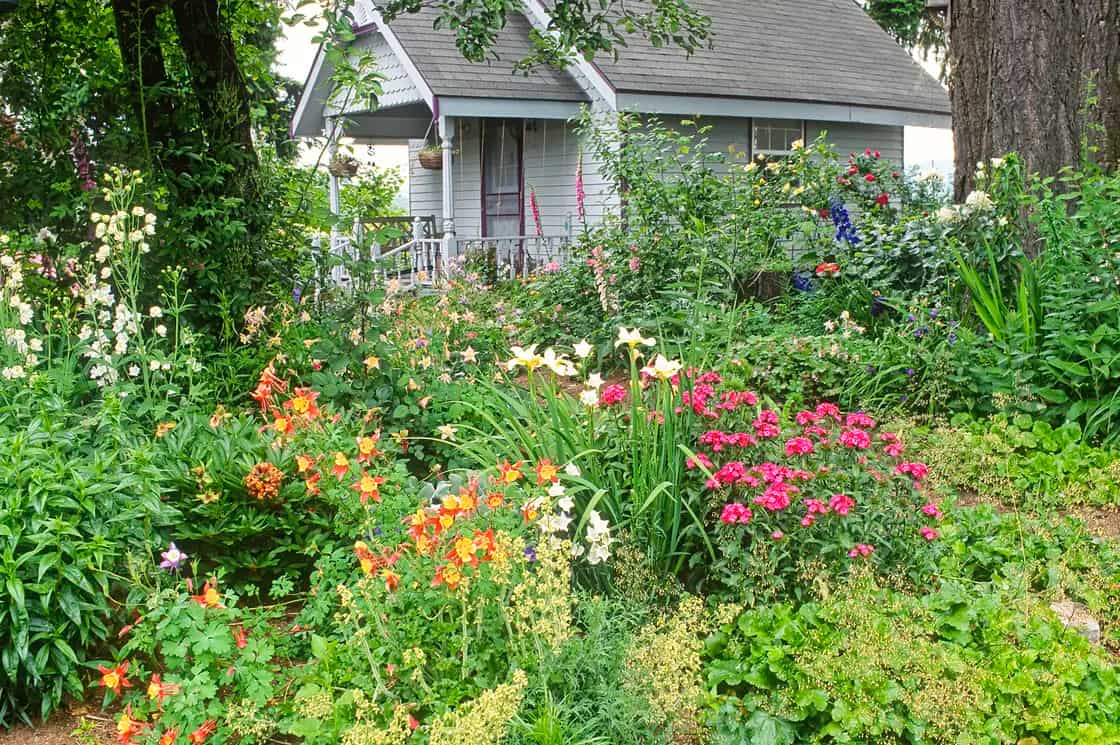Chaos Gardening | Environmental Benefits

Share
What is Chaos Gardening?
Chaos gardening is a concept that merges elements of chaos theory and gardening practices, aiming to create dynamic and resilient ecosystems that mimic the natural world. It is an approach that embraces complexity, diversity and the inherent unpredictability of nature. Rather than imposing strict control and order, chaos gardening encourages a more relaxed and intuitive approach to cultivate plants and managing landscapes.
Chaos gardening challenges traditional notions of gardening and landscaping, which often prioritize uniformity and control over natural processes. Instead, chaos gardening recognizes that nature is inherently chaotic, with interconnected relationships and intricate systems. By working with, rather than against, these natural processes, chaos gardeners aim to create harmonious and sustainable environments that can thrive with minimal intervention.
Chaos Gardening Permits Bio-Diversity
One of the fundamental principles of chaos gardening is the promotion of biodiversity. By incorporating various plant species, chaos gardeners create a tapestry of life that supports numerous beneficial organisms, such as insects, birds, and soil microorganisms. This diversity helps to create a more resilient ecosystem, making it less susceptible to pests, diseases, and environmental fluctuations. Additionally, different plants can provide various ecological services, such as attracting pollinators, improving soil fertility, or providing shelter for wildlife.
In chaos gardening, the focus is not solely on the result but on the processes and interactions that unfold within the garden. Gardeners allow for self-seeding and natural regeneration, letting plants find their niches and establish a dynamic equilibrium. The garden evolves and changes, with unexpected combinations and patterns emerging. It requires a willingness to embrace the wild and relinquish control, allowing the park to express its innate creativity.
Chaos Gardening Helps Improve The Soil and Fertility
Another critical aspect of chaos gardening is the reduction of artificial inputs and reliance on chemical interventions. Instead of synthetic fertilizers, herbicides abd pesticides, chaos gardeners employ natural methods to promote plant health and combat pests. For example, companion planting, where certain plants are grown together for mutual benefits, can help control pests and promote nutrient cycling. Mulching and composting improve soil structure and fertility, reducing the need for additional inputs.
Chaos gardening also emphasizes the importance of observing and learning from nature. By closely following the interactions between plants, insects, and other organisms, gardeners can gain insights into the underlying principles and patterns that govern ecological systems. This knowledge can be applied to design and manage more sustainable and resilient landscapes.
While chaos gardening celebrates diversity and complexity, it does not imply a complete abandonment of structure or design. Instead, it encourages a balance between spontaneity and intentional intervention. Gardeners may prune or shape plants selectively to maintain desired aesthetics or manage to overcrowd. However, they do so in a way that respects the plants' natural growth patterns and inherent characteristics, aiming to enhance rather than suppress their intrinsic beauty.
Chaos Gardening Promotes The Usage of Wild and Native Plants
In summary, chaos gardening is an approach that embraces the chaos and complexity of nature, seeking to create vibrant and resilient ecosystems. By promoting biodiversity, minimizing artificial inputs, and observing natural processes, chaos gardeners aim to cultivate dynamic landscapes that mimic the patterns and principles of the natural world. It is a philosophy that challenges conventional notions of control and order, inviting gardeners to embrace the beauty and unpredictability of nature's creative force.
Chaos gardening, also known as wild or natural gardening, is a practice that involves embracing biological processes and allowing plants to grow in a more untamed and uncontrolled manner. While the basic principles of chaos gardening remain the same, there might be a few updates and considerations to keep in mind in recent times. Here are some ways chaos gardening might be different now:
- Native plant focus: With increasing awareness about conservation and biodiversity, there is a greater emphasis on using native plants in gardening practices. Native plants are better adapted to local conditions and support local ecosystems, providing food and shelter for native wildlife. When practicing chaos gardening, consider incorporating a variety of native plants to create a more sustainable and ecologically beneficial garden.
- Climate considerations: Climate change has altered weather patterns in many regions. It's essential to consider the changing climate when choosing plants for your chaotic garden. Look for species that are resilient and can adapt to changing conditions. Additionally, select plants that can handle extreme temperatures, drought, or excessive rainfall, depending on the specific challenges of your area.
- Invasive species management: Invasive plant species can quickly take over a garden and disrupt the balance of ecosystems. It's crucial to be aware of invasive species in your region and take measures to prevent their spread. Regularly monitor your chaos garden for any invasive plants and take action to remove them promptly.
- Sustainable practices: Recently, there has been an increased focus on sustainable gardening practices. Consider incorporating sustainable techniques such as composting, water conservation methods, and organic fertilizers when practicing chaos gardening. These practices minimize environmental impact and promote healthier soil and plants.
- Wildlife-friendly approach: Chaos gardening can create a welcoming habitat for various wildlife species. To enhance your garden's biodiversity, incorporate bird feeders, butterfly-friendly plants, and water sources like birdbaths or small ponds. Provide suitable shelter, nesting spots, and hiding places for wildlife, making your garden a sanctuary for plants and animals.
- Community involvement: Engaging with the community and sharing knowledge about chaos gardening can be essential to the practice. Consider joining local gardening groups, participating in seed swaps, or hosting workshops to promote the benefits of chaos gardening and inspire others to embrace a more natural approach.
Remember, chaos gardening is about embracing nature's diversity and allowing the garden to evolve uniquely. While adapting to the changing times, it remains a way to reconnect with the natural world and create a beautiful, ecologically sound landscape.
